Finite Element Modeling and Simulation of a Submerged Wave Energy Converter System for Application to Oceanic Islands in Tropical Atlantic
Abstract
:1. Introduction
2. Materials and Methods
2.1. Oceanographic Data
2.2. Characterization of the Operational State of the Sea
2.3. Characterization of the Extreme State of the Sea
2.4. WEC System Configurations
2.4.1. Architecture of the WEC
- The existing systems previously studied and commercially available materials and components;
- The literature concerning the conversion of marine energy since a great deal of research has been carried out on different systems;
- A study commissioned by the Federal University of Pernambuco (UFPE, Brazil) for a wave energy system to be installed in the open sea region of Fernando de Noronha Island, which has no visual or environmental impacts.
- The panel: Attached to the base at the rotation axis, the panel is moved by the oscillation of the waves. It is 15 m wide and 10 m high. The distance between the top of the panel, that is fully submerged, and the surface of the water is 3 m. The rotation of the panel relative to the base is provided by a 0.5 m diameter shaft. The panel consists of a 10 mm thick high-density polyethylene (HDPE) shell, reinforced by a polyurethane foam to prevent the panel from crushing under water pressure.
- Vertical reinforcements: Two frames (200 mm wide and 20 mm thick) of stainless steel AISI 316 are added to the panel to ensure its integrity, while offering suitable corrosion resistance. The vertical reinforcements have the purpose of withstanding these loadings that arise during the operation of the system.
- The base: The base structure is composed of concrete and enables the system to be anchored to the ocean floor to ensure its stability. It is 11 m long, 12 m wide and 2 m high.
- Hydraulic cylinders: Thanks to the oscillation of the panel, these allow the pumping of a fluid in a high-pressure circuit for the conversion into wave energy. In this study, the cylinders were chosen based on commercial information obtained in the market of components used for offshore applications.
2.4.2. Summary of Material Properties
2.4.3. Mass Balance
2.5. Numerical Model
2.5.1. Geometry of the Model
2.5.2. Mesh Properties
2.5.3. Flow and Fluid Modeling
Wave Theory
Boundaries and Sea Conditions
3. Results and Discussion
3.1. Velocity Calculation Associated to Wave Conditions
3.2. Velocity Profiles
3.3. Determination of the Horizontal Velocity of Waves as a Function of Depth
3.3.1. Panel at 0°
3.3.2. Panel at 30°
3.3.3. Panel at 45°
3.4. Preliminary Assessment of the Mechanical Behavior of the WEC System
- The pressure distribution on the panel due to the maximum swell scenario;
- The hydrostatic pressure;
- Gravity.
4. Conclusions
Author Contributions
Funding
Institutional Review Board Statement
Data Availability Statement
Acknowledgments
Conflicts of Interest
References
- Baruch-Mordo, S.; Kiesecker, J.M.; Kennedy, C.M.; Oakleaf, J.R.; Opperman, J.J. From Paris to practice: Sustainable imple-mentation of renewable energy goals. Environ. Res. Lett. 2019, 14, 024013. [Google Scholar] [CrossRef]
- Mele, M.; Gurrieri, A.R.; Morelli, G.; Magazzino, C. Nature and climate change effects on economic growth: An LSTM experiment on renewable energy resources. Environ. Sci. Pollut. Res. 2021, 28, 41127–41134. [Google Scholar] [CrossRef] [PubMed]
- Gielen, D.; Gorini, R.; Wagner, N.; Leme, R.; Gutierrez, L.; Prakash, G.; Asmelash, E.; Janeiro, L.; Gallina, G.; Vale, G.; et al. Global Energy Transformation: A roadmap to 2050; International Renewable Energy Agency: Abu Dhabi, United Arab Emirates, 2018. [Google Scholar]
- Sandu, M.; Gribincea, A. Trends on the global energy Market. J. Res. Trade Manag. Econ. Dev. 2019, 11, 119–129. [Google Scholar]
- Jin, S.; Greaves, D. Wave energy in the UK: Status review and future perspectives. Renew. Sustain. Energy Rev. 2021, 143, 110932. [Google Scholar] [CrossRef]
- Nguyen, P.Q.P.; Dong, V.H. Ocean Energy—A Clean Energy Source. Eur. J. Eng. Technol. Res. 2019, 4, 5–11. [Google Scholar] [CrossRef]
- International Renewable Energy Agency (IRENA). Renewable Power Generation Costs in 2014. Available online: http://www.irena.org/ (accessed on 1 September 2022).
- Qiao, D.; Haider, R.; Yan, J.; Ning, D.; Li, B. Review of Wave Energy Converter and Design of Mooring System. Sustainability 2020, 12, 8251. [Google Scholar] [CrossRef]
- Pelc, R.; Fujita, R.M. Renewable energy from the ocean. Mar. Policy 2002, 26, 471–479. [Google Scholar] [CrossRef]
- Czech, B.; Bauer, P. Wave Energy Converter Concepts: Design Challenges and Classification. IEEE Ind. Electron. Mag. 2012, 6, 4–16. [Google Scholar] [CrossRef]
- Isaacs, J.; Seymour, R. The ocean as a power resource. Int. J. Environ. Stud. 1973, 4, 201–205. [Google Scholar] [CrossRef]
- Gunn, K.; Stock-Williams, C. Quantifying the global wave power resource. Renew. Energy 2012, 44, 296–304. [Google Scholar] [CrossRef]
- Izadparast, A.H.; Niedzwecki, J.M. Estimating the potential of ocean wave power resources. Ocean Eng. 2011, 38, 177–185. [Google Scholar] [CrossRef]
- Ramezanzadeh, S.; Ozbulut, M.; Yildiz, M. A Numerical Investigation of the Energy Efficiency Enhancement of Oscillating Water Column Wave Energy Converter Systems. Energies 2022, 15, 8276. [Google Scholar] [CrossRef]
- Mørk, G.; Barstow, S.; Kabuth, A.; Pontes, M.T. Assessing the global wave energy potential. In Proceedings of the 29th International Conference on Ocean, Offshore Mechanics and Arctic Engineering (OMAE), Shanghai, China, 6–11 June 2010. [Google Scholar]
- Rusu, E. Evaluation of the Wave Energy Conversion Efficiency in Various Coastal Environments. Energies 2014, 7, 4002–4018. [Google Scholar] [CrossRef]
- Rusu, E.; Onea, F. Estimation of the wave energy conversion efficiency in the Atlantic Ocean close to the European islands. Renew. Energy 2016, 85, 687–703. [Google Scholar] [CrossRef]
- Shadman, M.; Silva, C.; Faller, D.; Wu, Z.; de Freitas Assad, L.P.; Landau, L.; Levi, C.; Estefen, S.F. Ocean Renewable Energy Potential, Technology, and Deployments: A Case Study of Brazil. Energies 2019, 12, 3658. [Google Scholar] [CrossRef]
- Prasad, K.A.; Chand, A.A.; Kumar, N.M.; Narayan, S.; Mamun, K.A. A Critical Review of Power Take-Off Wave Energy Technology Leading to the Conceptual Design of a Novel Wave-Plus-Photon Energy Harvester for Island/Coastal Communities’ Energy Needs. Sustainability 2022, 14, 2354. [Google Scholar] [CrossRef]
- Wu, J.; Qin, L.; Chen, N.; Qian, C.; Zheng, S. Investigation on a spring-integrated mechanical power take-off system for wave energy conversion purpose. Energy 2022, 245, 123318. [Google Scholar] [CrossRef]
- Stansby, P.; Moreno, E.C.; Draycott, S.; Stallard, T. Total wave power absorption by a multi-float wave energy converter and a semi-submersible wind platform with a fast far field model for arrays. J. Ocean Eng. Mar. Energy 2021, 8, 43–63. [Google Scholar] [CrossRef]
- Rusu, E.; Onea, F. A review of the technologies for wave energy extraction. Clean Energy 2018, 2, 10–19. [Google Scholar] [CrossRef]
- Cornett, A.M. A Global Wave Energy Resource Assessment. In Proceedings of the Eighteenth International Offshore and Polar Engineering Conference, Vancouver, Canada, 6–11 July 2008. [Google Scholar]
- Cagninei, A.; Raffero, M.; Bracco, G.; Giorcelli, E.; Mattiazzo, G.; Poggi, D. Productivity analysis of the full scale inertial sea wave energy converter prototype: A test case in Pantelleria Island. J. Renew. Sustain. Energy 2015, 7, 061703. [Google Scholar] [CrossRef]
- Waveroller the Tidal Wave of Dcns. Available online: https://www.econology.info/forums/energies-renewable/waveroller-thetidal-wave-of-dcns-t11924.html (accessed on 1 September 2022).
- Edlund, M. Introduction to Minesto. In Proceedings of the North Sea Climate Conference, Marstrand, Sweden, 26 June 2019. [Google Scholar]
- U.S. Energy Information Administration (EIA). Based on EIA’s International Energy Statistics and Data from the International Energy Agency. 2021. Available online: https://www.eia.gov/todayinenergy/detail.php?id=49436 (accessed on 10 January 2023).
- Arinaga, R.A.; Cheung, K.F. Atlas of global wave energy from 10 years of reanalysis and hindcast data. Renew. Energy 2012, 39, 49–64. [Google Scholar] [CrossRef]
- WWF-BRASIL. Geração de Energia em Fernando de Noronha. Alternativas para a Diminuição de Emissões de CO2 No Trans-Porte e Eletricidade. 2021. Available online: https://wwfbr.awsassets.panda.org/downloads/geracao_de_energia_fernando_de_noronha_versao_web_1.pdf (accessed on 20 January 2023).
- Kabeyi, M.J.B.; Olanrewaju, O.A. Sustainable Energy Transition for Renewable and Low Carbon Grid Electricity Generation and Supply. Front. Energy Res. 2022, 9, 743114. [Google Scholar] [CrossRef]
- Tiago, T.S.; Luciana, M. Optimization of Energy Hybrid System for an Isolated Community in Brazil. Int. J. Renew. Energy Res. 2016, 6, 1476–1481. [Google Scholar]
- Silveira, E.F.; de Oliveira, T.F.; Junior, A.C.P.B. Hybrid energy scenarios for Fernando de Noronha archipelago. Energy Procedia 2015, 75, 2833–3838. [Google Scholar]
- Lassalle, J.M.; Martínez, D.F. Optimisation of hybrid renewable energy systems on islands: A review. Isl. Stud. J. 2022, 17, 221–242. [Google Scholar] [CrossRef]
- Onea, F.; Rusu, E. An Evaluation of Marine Renewable Energy Resources Complementarity in the Portuguese Nearshore. J. Mar. Sci. Eng. 2022, 10, 1901. [Google Scholar] [CrossRef]
- Roy, A.; Auger, F.; Dupriez-Robin, F.; Bourguet, S.; Tran, Q.T. Electrical Power Supply of Remote Maritime Areas: A Review of Hybrid Systems Based on Marine Renewable Energies. Energies 2018, 11, 1904. [Google Scholar] [CrossRef]
- Ruellan, M. Méthodologie de Dimensionnement D’un Système de Recuperation de L’énergie des Vagues. École Normale Supéri-Eure de Cachan. Ph.D. Thesis, École Normale Supérieure de Cachan-ENS Cachan, Gif-sur-Yvette, France, 2007. [Google Scholar]
- Beirão, P.J.B.F.N.; Malça, C.M.D.S.P. Design and analysis of buoy geometries for a wave energy converter. Int. J. Energy Environ. Eng. 2014, 5, 91. [Google Scholar] [CrossRef]
- Susbielles, G.; Bratu, C.; Cavanié, M. Vagues et Ouvrages Pétroliers en Mer; Éditions TECHNIP: Paris, France, 1981. [Google Scholar]
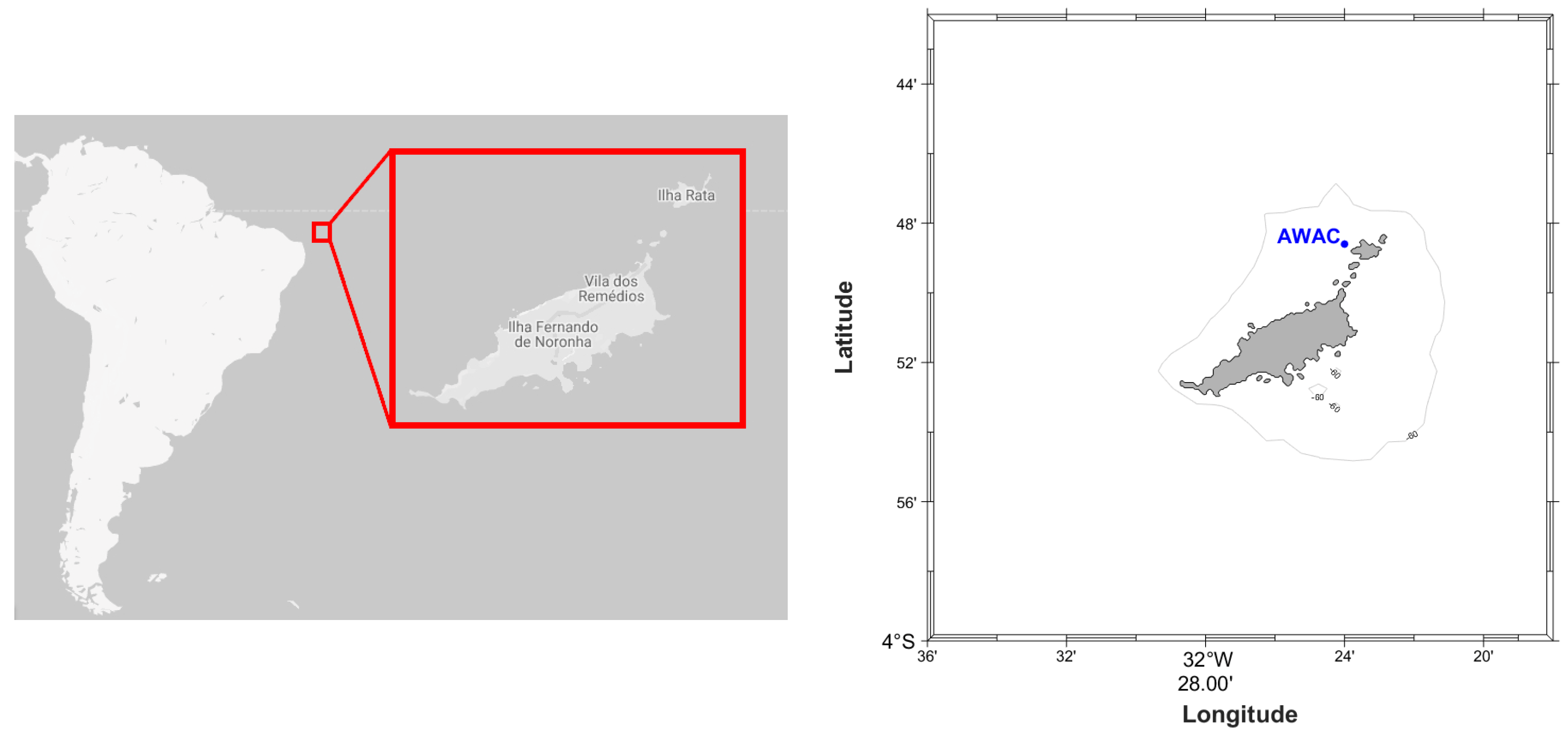
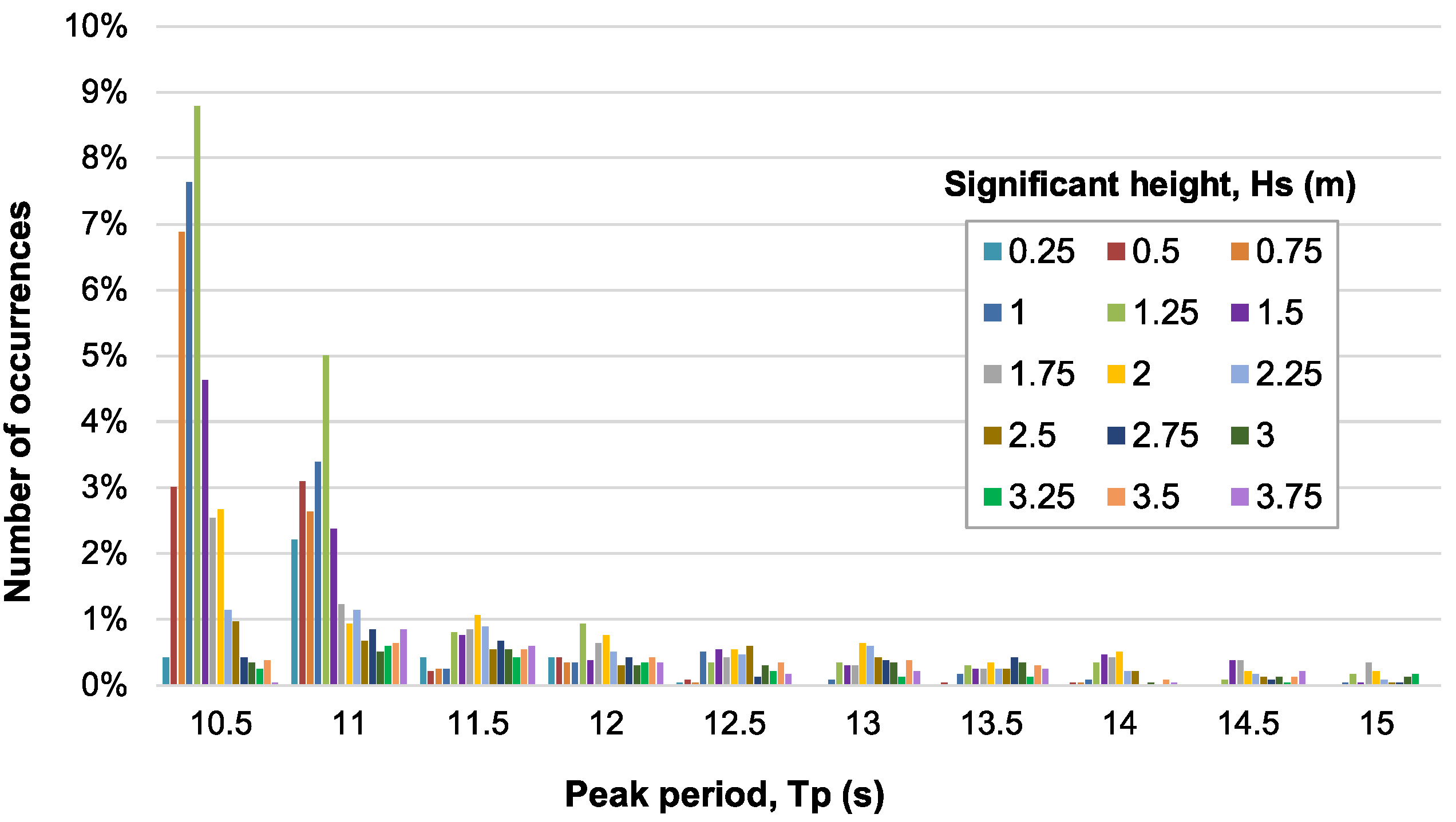


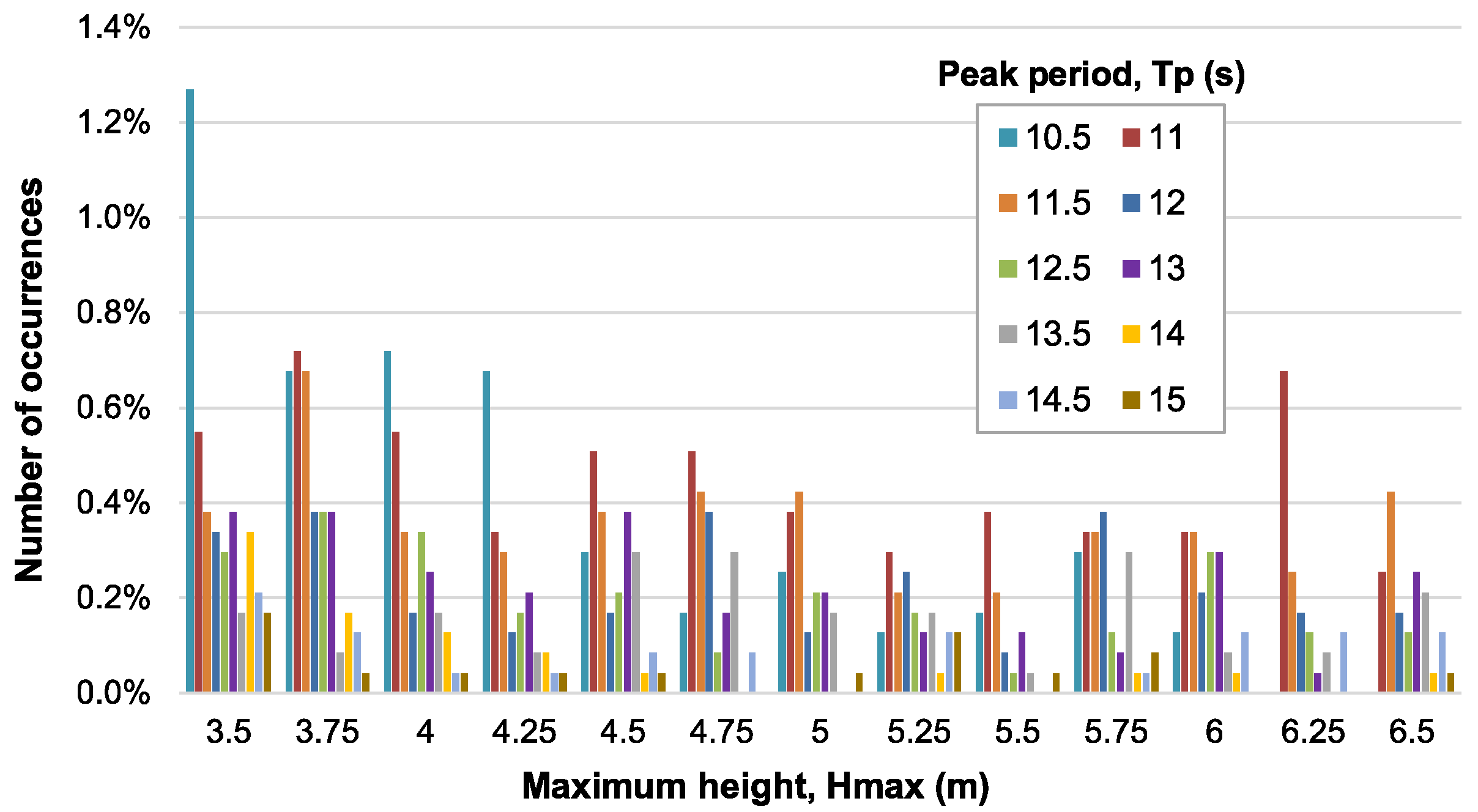
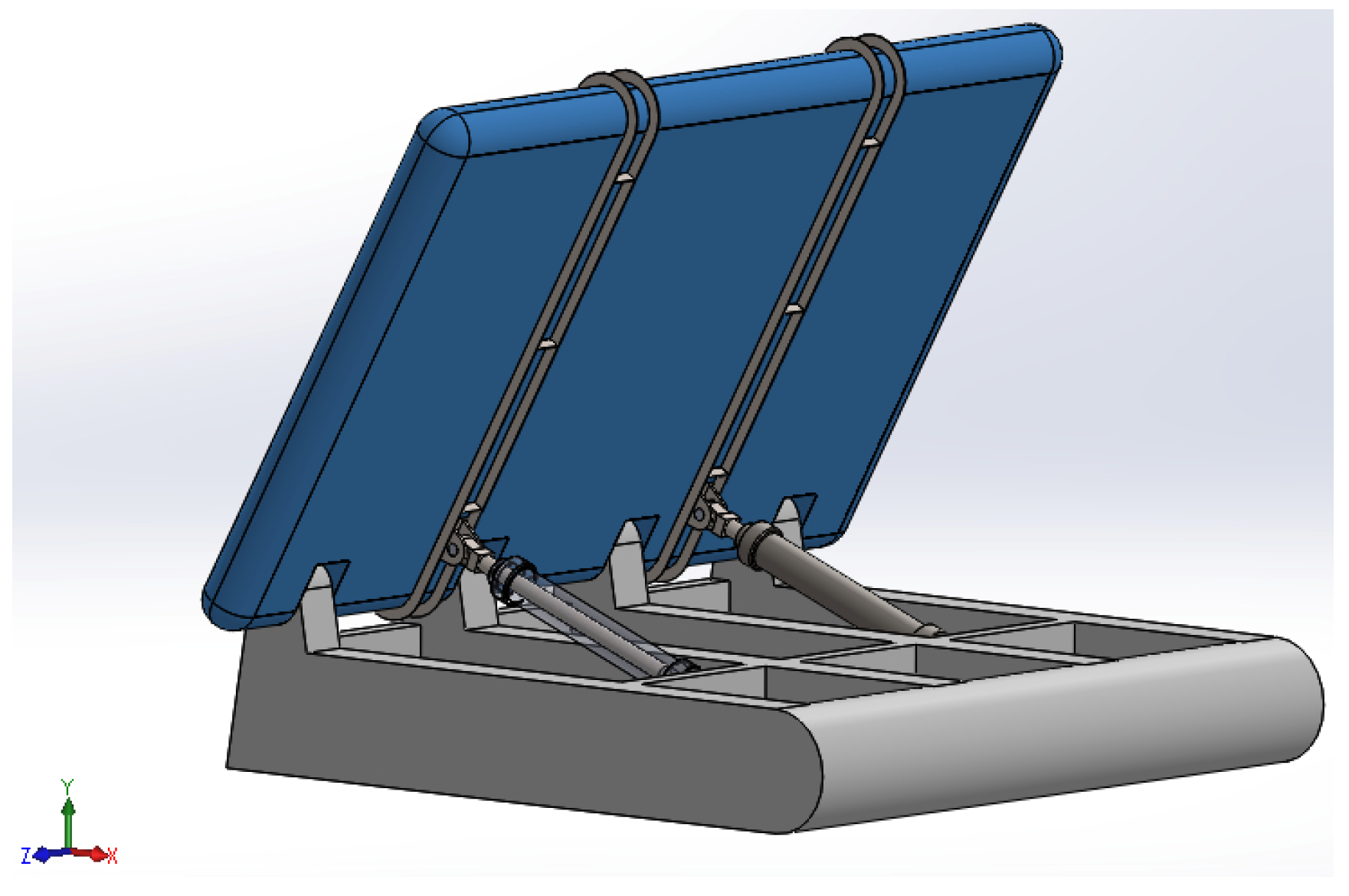



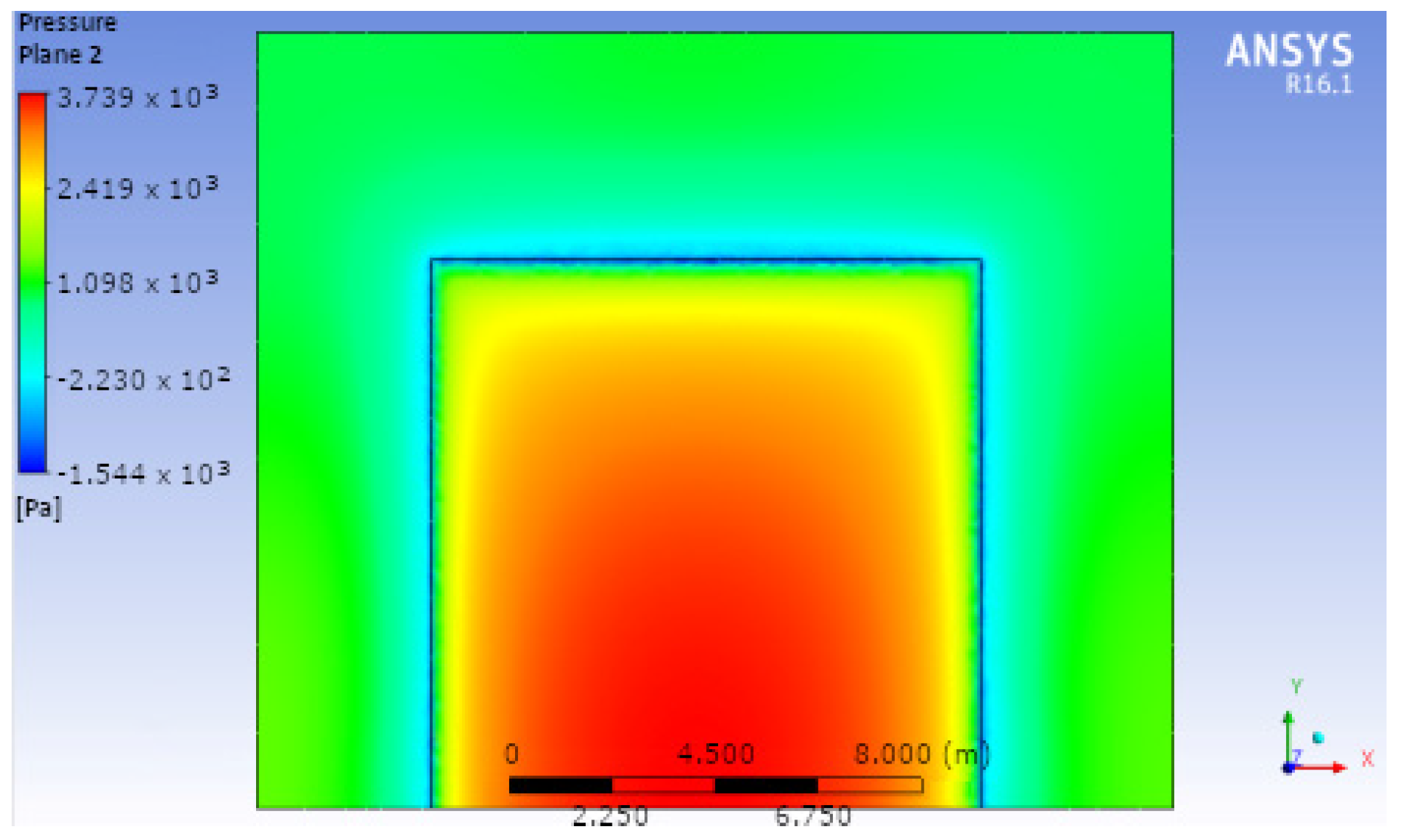
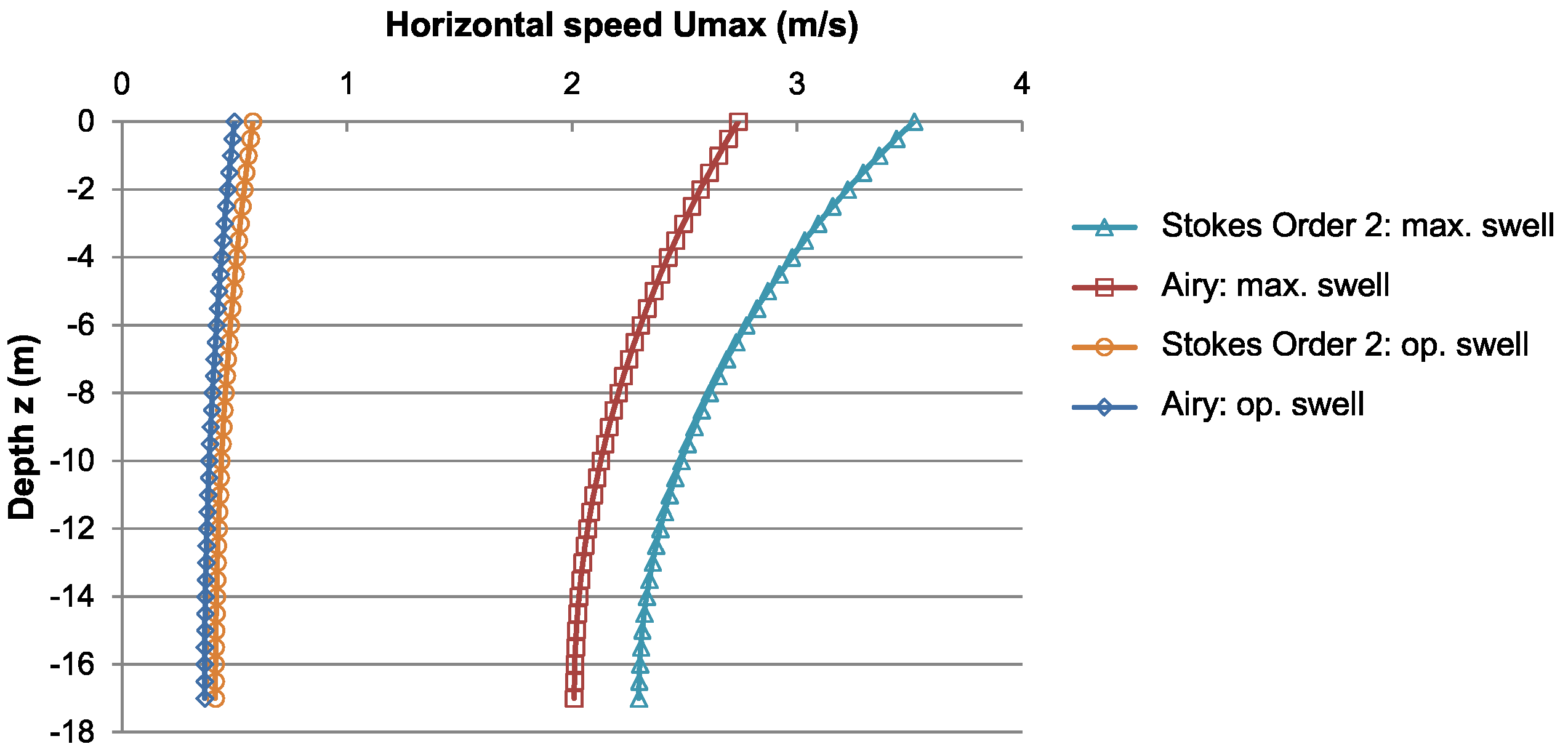


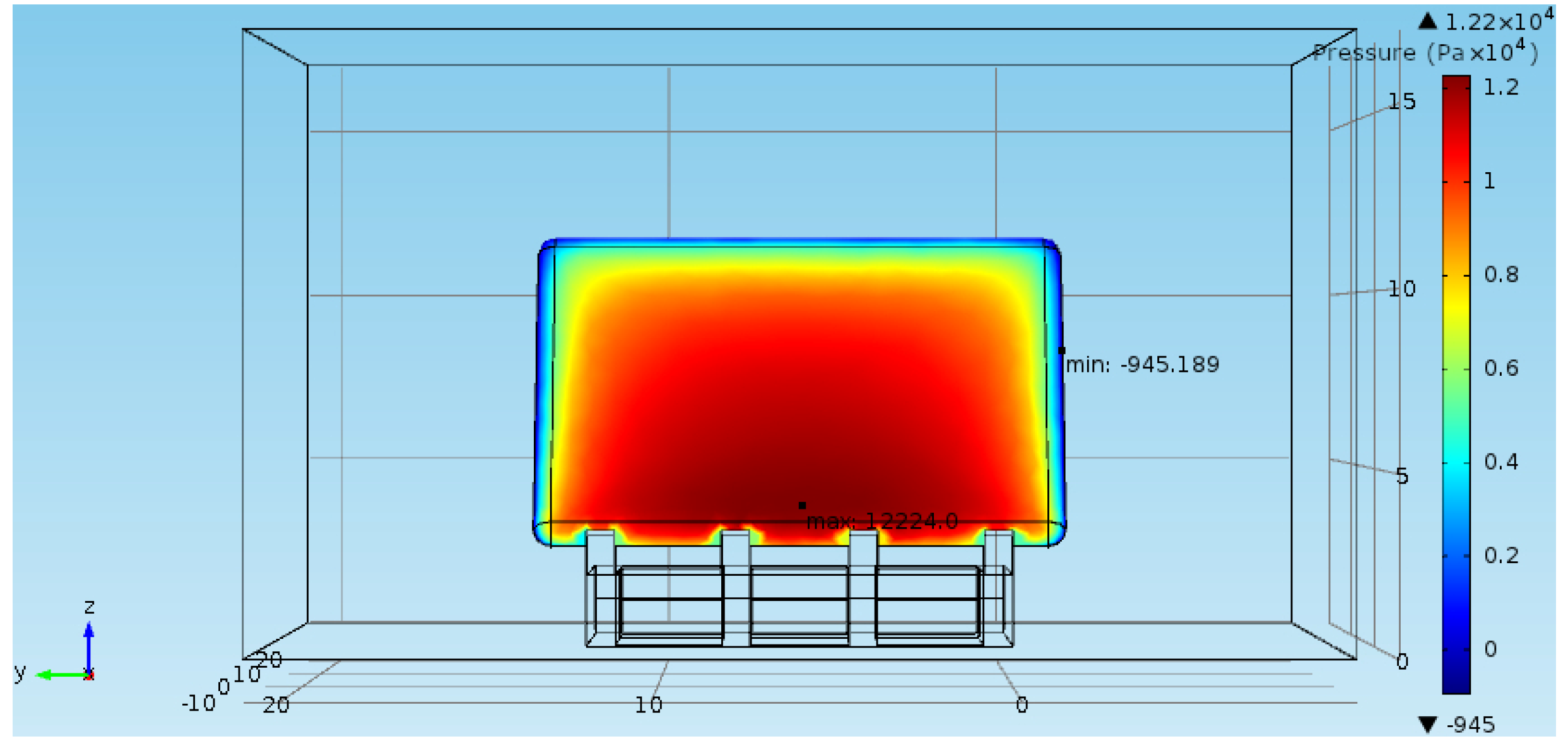
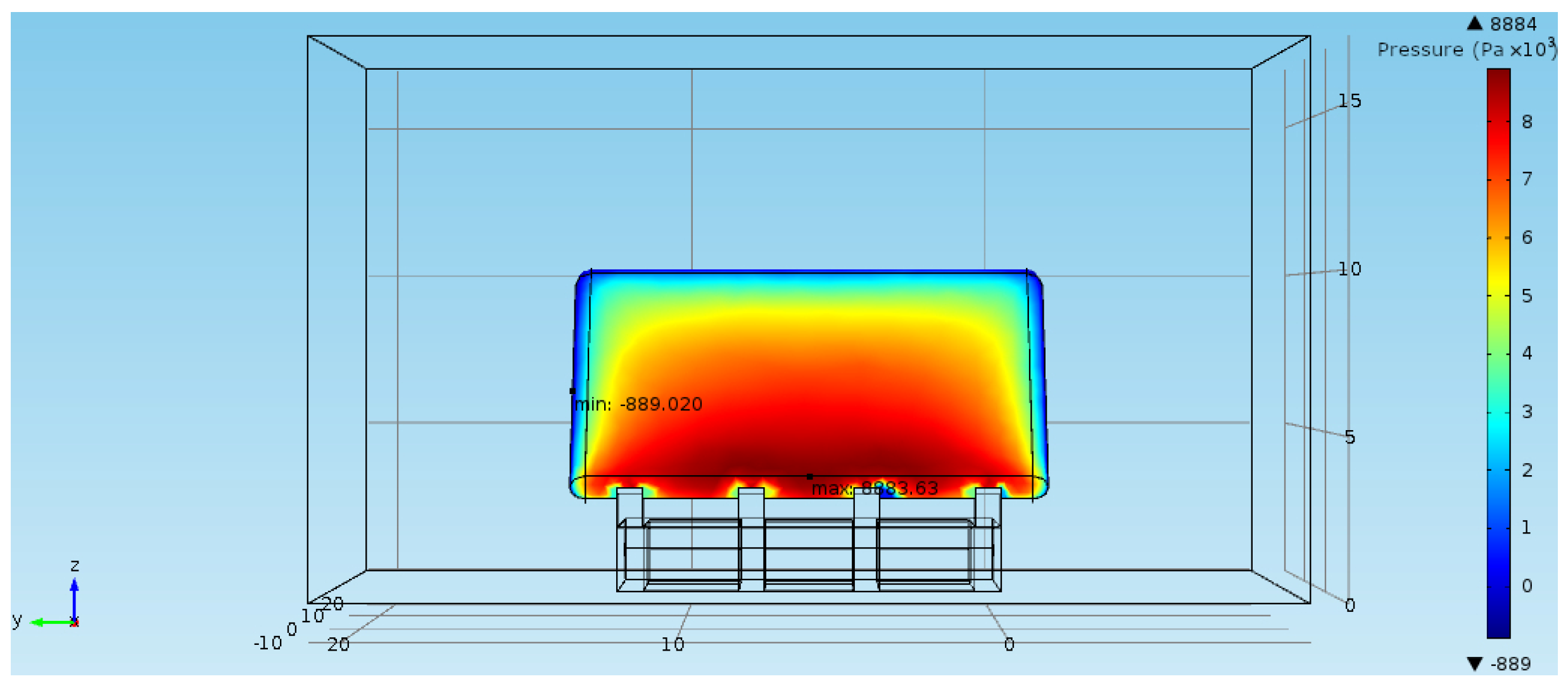

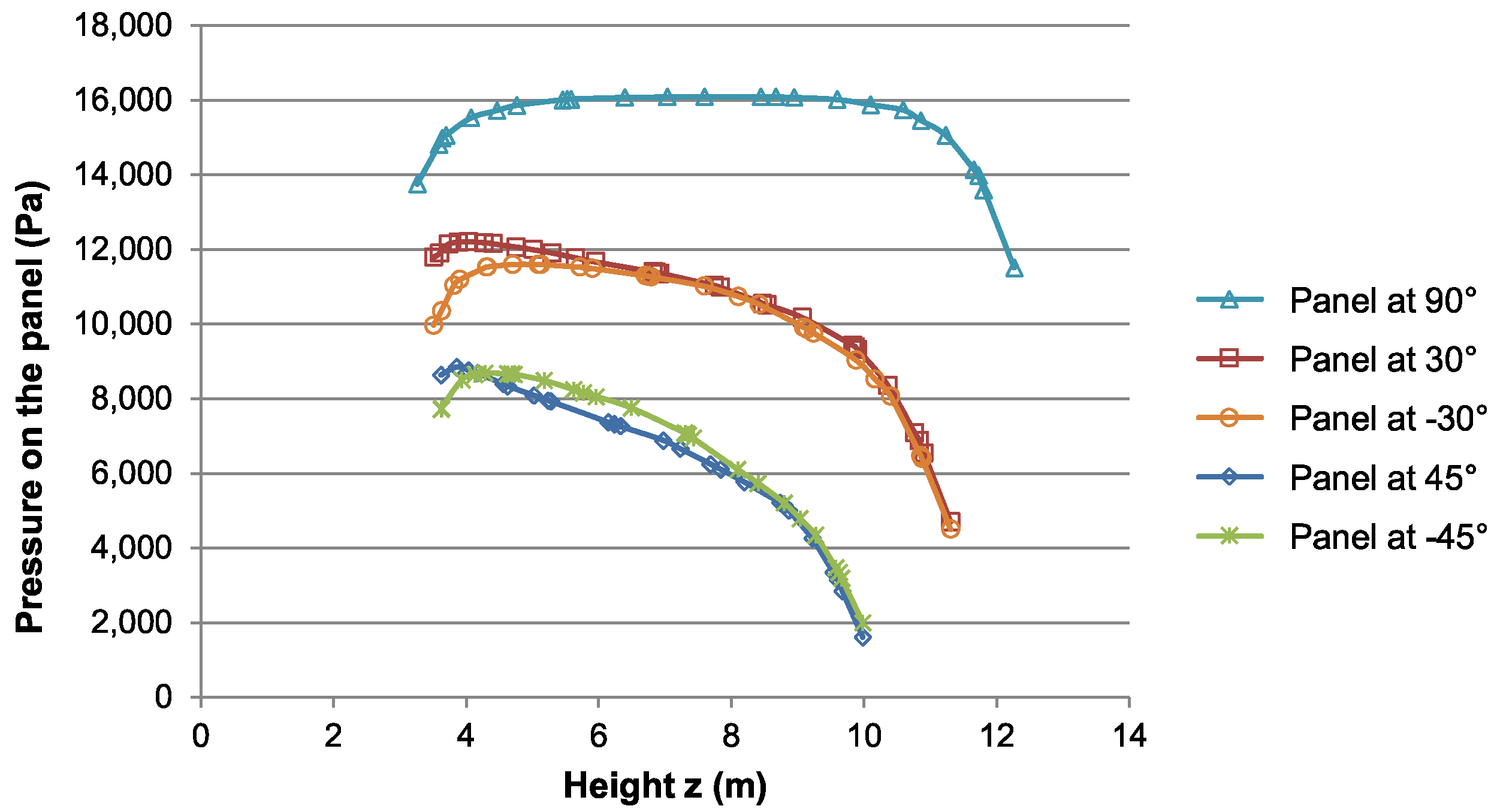
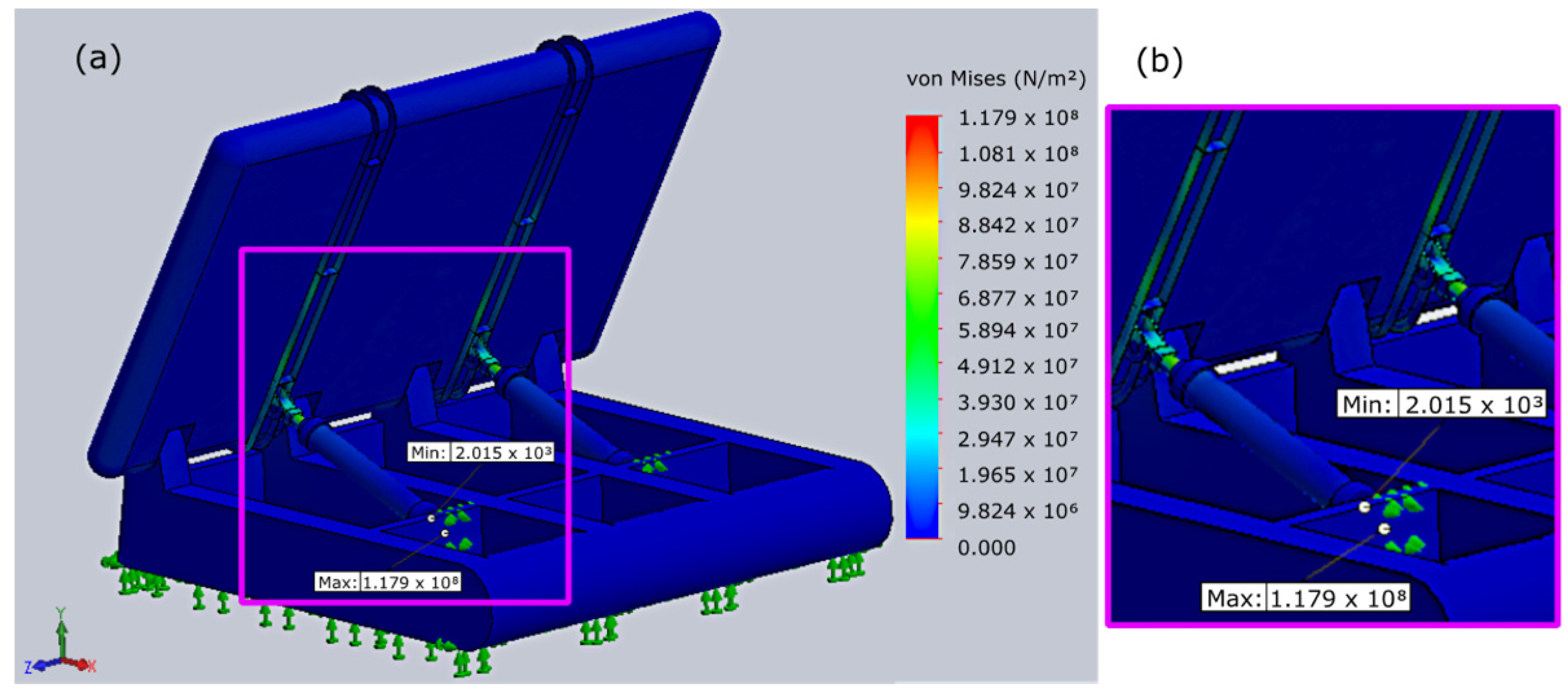
| Component | Materials | Young’s Modulus (MPa) | Poisson’s Coefficient | Yield Strength (MPa) | Density (kg/m3) |
|---|---|---|---|---|---|
| Hydraulic cylinders and vertical reinforcements | Stainless steel AISI 316 | 193,000 | 0.27 | 200 | 8000 |
| Panel shell | High-density polyethylene | 1860 | 0.46 | 30 | 950 |
| Internal part of the panel | Polyurethane foam | 2410 | 0.39 | 40 | 45 |
| Base | Concrete | 25,000 | 0.33 | 3000 | 2400 |
| Components | Materials | Volume (m3) | Weight (kg) |
|---|---|---|---|
| Panel (shell) | HDPE | 3.47 | 3299 |
| Panel (foam) | Polyurethane foam | 119.24 | 5366 |
| Reinforcements | Stainless steel AISI 316 | 0.19 | 1489 |
| Base | Concrete | 124.58 | 286,544 |
| Geometry of Each Part | Length x (m) | Height z (m) | Width y (m) |
|---|---|---|---|
| Fluid | 30 | 17 | 30 |
| Panel | 15 | 10 | 1 |
| Base | 12 | 2 | 11 |
| Mesh Characteristics | Maximum Size (m) | Minimum Size (m) | Fine Area Resolution (m) | Total Number of Elements |
|---|---|---|---|---|
| Mesh 1: “Fluid” | 2.80 | 1 | 0.30 | 109,415 |
| Mesh 2: “System” | 1.65 | 0.12 | 0.70 |
| Mesh Size | Number of Nodes | Number of Elements | Computational Time | Maximum Pressure on the Panel (Pa) |
|---|---|---|---|---|
| Auto | 6526 | 31,932 | 4 min | 3.206 |
| 0.50 m | 82,879 | 459,437 | 10 min | 3.526 |
| 0.30 m | 366,692 | 2,095,039 | 40 min | 3.635 |
| 0.25 m | 628,312 | 3,616,189 | 54 min | 3.635 |
| 0.20 m | 1,217,590 | 7,057,718 | 2 h 30 min | 3.739 |
| 0.15 m | 2,861,030 | 16,705,994 | 4 h 30 min | 3.739 |
| Inlet Velocity (m/s) | Maximum Pressure on the Panel (Pa) | |
|---|---|---|
| ANSYS | COMSOL | |
| 0.5 | 928 | 912 |
| 1.0 | 3696 | 3581 |
| 1.5 | 8355 | 8057 |
| 2.0 | 14,790 | 14,423 |
| 3.0 | 33,423 | 33,055 |
| Number of elements | 7,057,718 | 30,919 |
| Boundary Conditions | Type | Values |
|---|---|---|
| Entrance side | Velocity U = f(z) | U = f(z) |
| Exit side | Pressure | 1 Pa |
| Lateral side | Symmetries | - |
| Upper side | Constant speed in the direction of flow | Umax = f(17) |
| Lower side | Sliding wall | - |
| System | Sliding wall | - |
| Parameters | Maximum Swell | Operational Swell |
|---|---|---|
| Wave height, H (m) | 6 | 1.25 |
| Peak period, Tp (s) | ≥11 | 10.5 |
| Wavelength, L (m) | 129 | 129 |
| Panel Inclination | Equation of the Trend Curve | Correlation Coefficient |
|---|---|---|
| −45° | P(z) = −3.1481z6 + 129.93z5 − 2207.3z4 + 19,730z3 − 97,880z2 + 255,221z − 264,086 | 0.9998 |
| −30° | P(z) = −1.1388z6 + 51.306z5 − 952.77z4 + 9301.7z3 − 50,284z2 + 142,466z − 153,361 | 0.9989 |
| 0° | P(z) = −0.6235z6 + 28.484z5 − 535.27z4 + 5287.1z3 − 28,933z2 + 83,228z − 82,485 | 0.9987 |
| 30° | P(z) = −0.5815z6 + 24.932z5 − 444.82z4 + 4205.3z3 − 22,141z2 + 61,056z − 56,216 | 0.9993 |
| 45° | P(z) = −1.6868z6 + 67.455z5 − 1117.4z4 + 9775.6z3 − 47,489z2 + 120,496z − 115,169 | 0.9995 |
| Panel Inclination | HDPE Panel | Steel Reinforcements (Value—Location) |
|---|---|---|
| −45° | 23 | 154—Cylinder body |
| −30° | 11 | 113—Reinforcements |
| 0° | 76 | 316—Reinforcements |
| 30° | 24 | 118—Cylinder body/base connection |
| 45° | 27 | 82—Reinforcements |
Disclaimer/Publisher’s Note: The statements, opinions and data contained in all publications are solely those of the individual author(s) and contributor(s) and not of MDPI and/or the editor(s). MDPI and/or the editor(s) disclaim responsibility for any injury to people or property resulting from any ideas, methods, instructions or products referred to in the content. |
© 2023 by the authors. Licensee MDPI, Basel, Switzerland. This article is an open access article distributed under the terms and conditions of the Creative Commons Attribution (CC BY) license (https://creativecommons.org/licenses/by/4.0/).
Share and Cite
Bouchonneau, N.; Coutrey, A.; Bruère, V.M.; Araújo, M.; da Silva, A.C. Finite Element Modeling and Simulation of a Submerged Wave Energy Converter System for Application to Oceanic Islands in Tropical Atlantic. Energies 2023, 16, 1711. https://doi.org/10.3390/en16041711
Bouchonneau N, Coutrey A, Bruère VM, Araújo M, da Silva AC. Finite Element Modeling and Simulation of a Submerged Wave Energy Converter System for Application to Oceanic Islands in Tropical Atlantic. Energies. 2023; 16(4):1711. https://doi.org/10.3390/en16041711
Chicago/Turabian StyleBouchonneau, Nadège, Arnaud Coutrey, Vivianne Marie Bruère, Moacyr Araújo, and Alex Costa da Silva. 2023. "Finite Element Modeling and Simulation of a Submerged Wave Energy Converter System for Application to Oceanic Islands in Tropical Atlantic" Energies 16, no. 4: 1711. https://doi.org/10.3390/en16041711
APA StyleBouchonneau, N., Coutrey, A., Bruère, V. M., Araújo, M., & da Silva, A. C. (2023). Finite Element Modeling and Simulation of a Submerged Wave Energy Converter System for Application to Oceanic Islands in Tropical Atlantic. Energies, 16(4), 1711. https://doi.org/10.3390/en16041711







